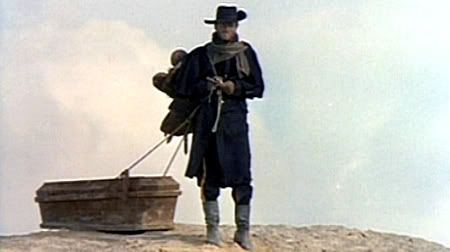
Sergio Leone's Italian Westerns, such as 1964's Fistful of Dollars , 1965's For A Few Dollars More , and 1966's The Good, The Bad and The Ugly , have rightly been credited with popularizing the "spaghetti western" craze of the 60s and 70s. But there was another director from Italy -Sergio Corbucci (1927-1990)- who also helped shape and mold the Eurowestern genre. A cameraman who got his start as a director with such sword-and-sandal/peplum flicks as 1961's Duel of the Titans , Corbucci directed two "traditional" westerns, Massacre at Grand Canyon (starring Robert Mitchum's son James) and Minnesota Clay (starring Cameron Mitchell) in 1965, before viewing his friend & colleague Leone's films. After that, Corbucci decided to craft his own unique vision of the American West (albeit through location shooting in Almeria, Spain, with interiors shot in Italy), one that didn't owe it's influences to American Westerns or to Leone's own Tongue-in Cheek take.

Django (Franco Nero), a mysterious drifter who "went away" from a nameless, ugly-looking town to fight in the Civil War (and apparently long after the war's end) returns to the town which is in a tug-of-war between two opposing factions: the bigoted Major Jackson (Eduardo Fajardo) and his red-hooded KKK-like racist thugs, and a roving band of Mexican bandits led by an apparently old friend of Django's, "General" Hugo Rodriguez (Jose Bodalo). Both gangs hate each other and are ripe for the picking -or so the viewer thinks- when Django plots to get revenge on Jackson (for killing Django's wife) by playing the two groups against each other, not unlike the plan concocted by Clint Eastwood's "Joe" in Fistful of Dollars . But it quickly turns out that Django has drastically underestimated his foes...

To say more would ruin the bizarre and unexpected surprises this film has to offer (like: what is in that coffin Django keeps dragging along with him, seen above). There are startling acts of violence & brutality in this picture (wanna see the scene involving a character's ear that Quintin Tarantino "borrowed" for his 1994 flick Pulp Fiction ? It's here...) but there's also, for all of it's grim and downbeat atmosphere (very unlike the tone of Leone's films), a powerful sense of pacing and spectacle -an attack on a Mexican Army fort is one of the most exciting sequences in any Italian Western, and is right up there with Leone- and a cast of memorable characters -both Django and the villians, as well as the bystanders (including Loredana Nusciak as the nominal love interest), stand out- that really propel this film along. Once you've watched Django , you won't forget it! Director Corbucci (who used the still-standing outdoor set from Leone's For A Few Dollars More, after first "dirtying up" the place) , despite a low budget, does a terrific job holding all the plot elements together, leading to an unforgettable climax.

The film was dubbed (badly) into English and although a big box office success in Europe, Asia & elsewhere, it never got released here in the States. Countless "sequels" by producers hoping to cash in the "Django" brand name came out in Europe, of which only a few (including 1967's Django Kill If You Live, Shoot! , directed by Giulio Questi and starring Cuban-American Tomas Milian , a veteran of Italian Westerns) showed any originality and/or quality.

(The original movie poster for Django Kill! .)
Currently Django (and Django Kill! , which is even more over the top in terms of violence & brutality) are both available on DVD from Blue Underground in restored editions with English & Italian soundtracks, optional English subtitles, various extras (including interviews with the still-living Nero & Milian) and can be found at the Greenwich Library. -Ed
Note: Sergio Leone's first two westerns will be airing on the
Turner Classic Movies cable channel tonight, beginning at 8:00 PM Eastern Time.
No comments:
Post a Comment